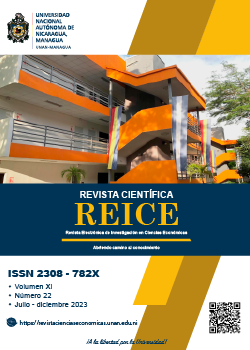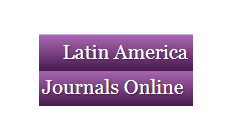Factores que afectan al valor de marca de la universidad de dong thap - investigación basada en los estudiantes
DOI:
https://doi.org/10.5377/reice.v11i22.17362Palabras clave:
Asociación, concienciación, valor de marca, lealtad, calidad percibida, valor de marca basado en el estudiante, marca universitariaResumen
La investigación analiza los factores que afectan al valor de marca de la Universidad de Dong Thap desde el punto de vista de los estudiantes a través de cuatro factores: conocimiento de marca, asociación de marca, calidad percibida y fidelidad a la marca. El estudio utiliza datos primarios mediante encuestas a estudiantes de la Universidad de Dong Thap y 298 respuestas recogidas mediante cuestionarios a través de un muestreo de conveniencia (muestreo no probabilístico). Los datos se analizaron para obtener estadísticas descriptivas, alfa de cronbach y otros análisis (es decir, análisis factorial exploratorio, estimación y pruebas de regresión). Los resultados muestran que los cuatro factores considerados afectaron al valor de marca de la Universidad de Dong Thap, seguidos de otros factores. Así pues, este valor de marca no sólo se ve afectado por las percepciones de los estudiantes, sino también por los servicios de formación. En consecuencia, la investigación pone de relieve las implicaciones prácticas y la dirección sugerente para que el personal directivo construya el valor de marca de la Universidad Dong Thap.
Descargas
Citas
Aaker, D. (1991). Building strong brands. New York: Free Press.
Aaker, D. A. (1996). Measuring brand equity across products and markets. California Management Review, 38(3), 102-120.
Ailawadi, K. L., Lehmann, D. R., & Neslin, S. A. (2003). Revenue premium as an outcome measure of brand equity. Journal of Marketing, 67(4), 1-17.
Agarwal, M. K., & Rao, V. R. (1996). An empirical comparison of consumer-based measures of brand equity. Marketing Letters, 7(3), 237-247.
A. Alkhawaldeh, A. Alsaad, A. Taamneh, and H. Alhawamdeh, “Examining antecedents and consequences of university brand image,” Management Science Letters, vol. 10, no. 5, pp. 953–960, 2020.
Chaudhuri, A., & Holbrook, M. B. (2001). The chain of effects from brand trust and brand affect to brand performance: the role of brand loyalty. Journal of Marketing, 65(2), 81-93.
Chu Nguyễn Mộng Ngọc. (2010). Giá trị cảm nhậm về đào tạo đại học từ góc nhìn sinh viên. Tạp chí Phát triển và Hội nhập, 4, 7-12.
Costello, A. B., & Osborne, J. (2005). Best practices in exploratory factor analysis: Four recommendations for getting the most from your analysis. Practical Assessment, Research, and Evaluation, 10(7), 1-9.
Dennis, C., Papagiannidis, S., Alamanos, E., & Bourlakis, M. (2016). The role of brand attachment strength in higher education. Journal of Business Research, 69(8), 3049-3057.
Dung, T. V. (2019). Customer based brand equity and university brand management. VNU Journal of Science: Economics and Business, 35(4), 94-106.
Jevons, C. (2006). Universities: a prime example of branding gone wrong. The Journal of Product and Brand Management, 15(7), 466-467.
J. M. Balmer, M. Urde, and S. A. Greyser, “Corporate brands with a heritage,” Working Paper, vol. 7, no. 8, pp. 2–24, 2007.
Kapferer, J. N. (2008). The new strategic brand management: Creating and sustaining brand equity long term. Kogan Page Publishers.
Keller, K. L. (1993). Conceptualizing, measuring, and managing customer-based brand equity. Journal of Marketing, 57(1), 1-22.
Keller, K. (2003). Strategic brand management: Building, measuring and managing brand equity (2nd ed.). Englewood Cliffs,NJ: Prentice-Hall.
Keller, K. L. (2001). Building customer-based brand equity: A blueprint for creating strong brands. Cambridge, MA: Marketing Science Institute, 3-27
Kim, H. B., Kim, W. G., & An, J. A. (2003). The effect of consumer‐based brand equity on firms’ financial performance. Journal of Consumer Marketing, 20(4), 335-351.
K. K. Twum, A. A. Yalley, and G. K.-Q. Agyapong, “The influence of Public University library service quality and library Brand image on user loyalty,” International Review on Public and Nonprofit Marketing, vol. 18 , no. 2 , pp. 1–22, 2021.
Law No. 34/2018/QH14 on amendments to the Law on higher education.
Mazzarol, T. W., & Soutar, G. N. (2008). Strategy matters: strategic positioning and performance in the education services sector. International Journal of Nonprofit and Voluntary Sector Marketing, 13(2), 141-151.
L. Leonard, “Cultivating service brand equity,” Journal Academy of Marketing Science, vol. 28, no. 1, pp. 128–137, 2000.
Mazzarol, T., & Soutar, G. (2008). Australian educational institutions' international markets: a correspondence analysis. International Journal of Educational Management, 22(3), 229-238.
Mourad, M., Ennew, C., & Kortam, W. (2011). Brand equity in higher education. Marketing Intelligence & Planning, 29(4), 403-420.
Netemeyer, R. G., Krishnan, B., Pullig, C., Wang, G., Yagci, M., Dean, D., & Wirth, F. (2004). Developing and validating measures of facets of customer-based brand equity. Journal of Business Research, 57(2), 209-224.
Nguyen Dinh Tho. (2011), Scientific research methods in business - Design and reality, Labor and Social Publishing House, Ho Chi Minh City.
Pham Thi Minh Ly. (2014). University brand equity as perceived by students - Research at universities in Ho Chi Minh City. Journal of Economics & Development, 200, 79-87.
Pinar, M., Trapp, P., Girard, T. and Boyt, T. (2014). University brand equity: an empirical investigation of its determinants. International Journal of Educational Management, 28(6), 616-634.
Q. Yu, Y. Asaad, D. A. Yen, and S. Gupta, “IMO and internal branding outcomes: an employee perspective in UK HE,” Studies in Higher Education, vol. 43, no. 1. pp. 37–56, 2018.
Supornpraditchai, T., Miller, K., Lings, I. N., & Jonmundsson, J. B. (2007). Employee-based brand equity: antecedents and consequences. In Australian and New Zealand Marketing Academy Conference. Otago University, 3-5 December, 1723-1733.
S. Panda, S. C. Pandey, X. Tian, and A. Bennett, “University brand image as competitive advantage: a two-country study,” International Journal of Educational Management, vol. 33, no. 2, pp. 234–251, 2019.
Tran Thi Yen Minh and Pham Thi Huong. (2017). Public awareness of the University of Danang brand. Journal of Science and Technology University of Danang, 2(111), 12-17.
Vu Thi Thu Ha. (2019). Student-oriented brand equity: research with the case of marketing departments at universities in Hanoi. Journal of Science and Technology, 52, 111-116.
Whisman, R. (2007). Internal branding: a university’s most intangible asset. Available at: www. brandchampionablog.com (accessed 20 September 2009).
W. Schlesinger, A. Cervera-Taulet, and W. Wymer, “The influence of university brand image, satisfaction, and university identification on alumni WOM intentions,” Journal of Marketing for Higher Education, vol. x , no. x, pp. 1–19, 2021.
Yoo, B., & Donthu, N. (2001). Developing and validating a multidimensional consumer-based brand equity scale. Journal of Business Research, 52(1), 1-14.
Yuan, R., Liu, M.J., Luo, J. and Yen, D.A. (2016). Reciprocal transfer of brand identity and image associations arising from higher education brand extensions. Journal of Business Research, 69(8), 3069-3076.

Descargas
Publicado
Cómo citar
Número
Sección
Licencia
Derechos de autor 2023 REICE: Revista Electrónica de Investigación en Ciencias Económicas

Esta obra está bajo una licencia internacional Creative Commons Atribución-NoComercial-CompartirIgual 4.0.


